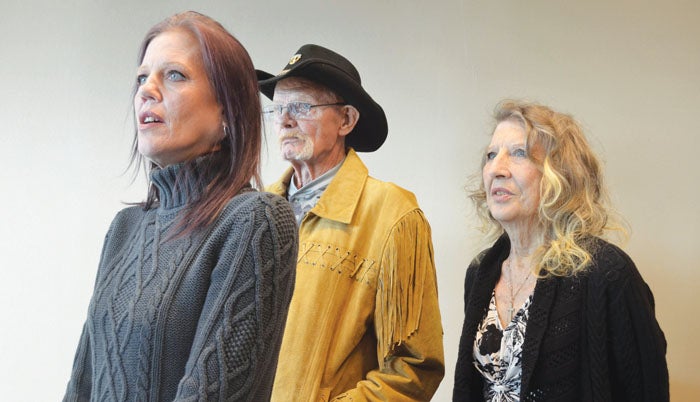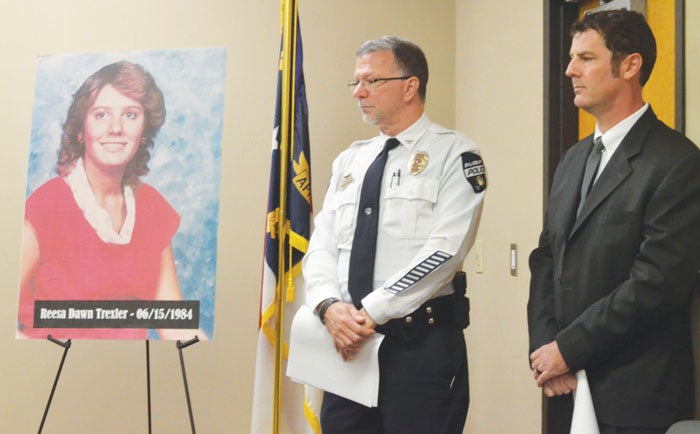Police, DNA technology solves 1984 murder of Reesa Trexler
Published 11:01 pm Tuesday, December 3, 2019
SALISBURY — New DNA technology is one of the many reasons Salisbury police detectives say they were able to solve the 35-year-old murder of Reesa Dawn Trexler, a teenager who was found stabbed to death at her grandfather’s North Shaver Street home, according to details revealed at a news conference Tuesday.
Officials would only say that the suspect was a black man and that the case has been cleared. However, the Post obtained a petition for the exhumation of the remains of Curtis Edward Blair, which were exhumed to conduct a forensic evaluation, court records show.
The petition indicates witnesses saw a black man running in the area of the crime scene at the time of the homicide. Investigators received information that Blair was employed by Frito-Lay in Salisbury, located two blocks from Trexler’s grandparents’ house.
According to the court documents, a case summary says investigators seized a knife belonging to “C. Blair” that was submitted to the state crime lab for analysis. No blood was detected on the knife.
The Salisbury Police Department submitted a DNA swab from a sexual assault kit and the lab was able to extract DNA and developed a male DNA profile. Police consulted with Parabon NanoLabs and submitted the profile for a genetic genealogy report. Based on genetic, genealogical and circumstantial evidence, Blair was a “very strong candidate to be the subject of the unidentified male extracted DNA profile,” court documents said.
Blair died on Aug. 6, 2004, court records show. At the time of his death, he lived in San Diego County, California. His remains were interred at Memorial Park Cemetery in Salisbury a few weeks later.
Trexler, 15, was found dead June 15, 1984. Her body was nude and lying on the floor in a bedroom of her granparents’ home. She had been stabbed several times in the upper chest and neck.
An autopsy later revealed the blade of a knife had broken off and was found in her right shoulder. The most significant stab wound was one that severed Trexler’s spinal cord, Detective Sgt. Travis Shulenburger said Tuesday.
The State Bureau of Investigation lab determined that semen was found in blood on her body. In 1984, detectives found a hair they determined to be from an African-American on her body at the crime scene.
Trexler’s grandfather, Walt Monroe, had been to the grocery store and his wife to the hairdresser at the time of the murder. There was no forced entry into the home, and the family said nothing was taken. The teenager was still wearing a bracelet, watch and ring.
Several people, including family members, were rumored to be suspects through the years, but no arrest was ever made.
Nine witnesses reporting seeing a black man in the area, with five of them saying they saw a black man running. The descriptions and direction of travel were not consistent with some of the information during the early stages of the investigation, Shulenburger said.
Trexler’s sister, Jodie Trexler Laird, appeared on “The Dr. Phil Show” in 2018 and passed a polygraph test that renewed interest in the case. She has been exonerated by the new evidence, and she was instrumental in closing the case, police said.
Police investigation
In 2018, Shulenberger told the Post that some evidence was never tested because of limited technology in 1984. That evidence was retested with the help of the N.C. State Crime Lab and Parabon NanoLabs Inc., a private lab based in Virginia.
Salisbury detectives and the SBI conducted new interviews and gathered DNA samples. In June 2018, police submitted swabs to the State Crime Lab for analysis, which revealed a male DNA profile that was obtained from sperm.
In March, police investigators sent a DNA extract from the sperm to Parabon NanoLabs for further analysis. On April 8, a genetic genealogy report provided a name based on the submitted DNA sample.
“The person identified by Parabon was a black male who was in his 40s at the time Reesa was murdered,” Shulenburger said.
He said the man had lived in Rowan County and was employed by a business in the general area of the crime scene. He had a criminal history of assault with a deadly weapon and he’d served jail time.
“The person identified by Parabon is now deceased,” Shulenburger said.
Police were able to obtain a sample from the body of Curtis Blair to compare with the swab taken from Trexler’s body and both were sent to the State Crime Lab. Lyerly Funeral Home offered the use of their facility to collect DNA and cared for his remains before reburial.
On Aug. 6, the State Crime Lab reported the major contributor of the sperm of the swab profile was consistent with the DNA profile obtained from Blair’s body.
“In absence of courtroom due process and conviction by a jury, his identity is not being released. The Salisbury Police Department and the State Bureau of Investigation do consider this case solved and now closed,” Shulenburger said.
He said Jodie Trexler was instrumental in bringing the case back to the police department’s attention.
“We would like to say that Jodie has been completely exonerated in this case and the suspect has no connection to the Trexler or Monroe family,” Shulenburger said.
Shulenburger said he heard about the Trexler case when he joined the police department. Over the years, many police and SBI investigators had worked on the case. He credited then-Investigator Jim Hurley and others who worked on the case over the years.
“It wouldn’t have been possible without the guys that worked the crime scene in 1984. They preserved evidence and collected evidence that made today possible. Those guys made all of this possible,” Shulenburger said.
He said the Trexler and Monroe families have gone through a lot over the years.
“I think we’re all happy that there is some closure. Nothing’s going to bring Reesa back but we have some closure to the case now,” Shulenburger said.
DNA submission
CeCe Moore, the chief genealogist with Parabon Labs, joined the news conference via Skype. Moore explained the process by which the lab was able to determine the DNA results.
Moore said the process is called SNP (pronounced “snip”) genotyping, a more advanced technology that had been previously used in law enforcement cases.
Analysts are able to look at a larger portion of the genetic code and, from that, predict distant cousins. Once they have analyzed DNA, they upload the results to a public database called GEDMatch. GEDMatch was used by law enforcement to identify a suspect in the Golden State Killer case in California.
Moore said this is the 88th case in which the Parabon team has helped identify the contributor of DNA from a crime scene.
“This is a revolutionary type of analysis, and once that DNA file is uploaded to GEDMatch it’s compared to the other participants there who have allowed law enforcement to use their profiles for comparison,” Moore said.
From the DNA profiles, analysts get a list of cousins or relatives. They then use the family trees of people who share significant amounts of DNA with the unknown suspect to reverse engineer the family tree. Moore said they are usually using second, third, and fourth cousins.
The techniques used were created for people who were adopted or who have unknown parentage in order to identify their biological families.
“We had a lot of success with that so we knew that the power of genetic genealogy could also help identify unknown suspects and unknown victims of violent crimes. In this case, we were able to do that based on people who uploaded their DNA files to GEDMatch and from that we could reverse engineer the identity of the suspect in this case,” she said.
State crime lab
N.C. Attorney General Josh Stein, who was in attendance Tuesday, congratulated the police department for its diligence in pursuing the case as well as his team at the State Crime Lab. Director Vanessa Martinucci was also at the news conference.
“Sometimes justice is swift; other times, it takes longer. And today after 35 years, this case is closed,” Stein said.
In the 35 years, the State Crime Lab conducted 10 different tests and produced 14 evidence reports in the Trexler case, he said.
“Fortunately, DNA science had come a long way since 1984 when this case began. DNA is a powerful tool,” Stein said. “It can incriminate someone, and it can exonerate someone. Today, thanks to determined law enforcement officers and forensic scientists, we are here to exonerate Jodie Trexler Laird and the family from any connection to this horrendous case.”
In 2017, the state lab discovered 15,000 untested sexual assault kits, more than in any other state in the nation. Stein said analysts have worked hard to address the issue because testing DNA can breath life into cold cases.
He noted a 42-year-old homicide in Johnston County that was solved earlier this year with the help of DNA testing. The victim was sexually assaulted and murdered. Her daughter also was murdered. Through police work and technology, investigators were able to resolve that case, Stein said.
“When we test these kits, we solve crimes telling rapists that no matter how long ago their crime occurred, we will come after them and telling victims and loved ones that we value them and we want to make our communities safe,” Stein said. “We will fight for you whether it’s 10, 20, 30 or even 35 years ago that the crime occurred here today.”
Police Chief Jerry Stokes asked for the community’s help in bringing other cold cases to a close, including those of 7-year-old A’yanna Allen, Jonathan Dillard, William Henderson as well as the 2002 Catawba College students Matthew Greear and Walter Frank Long.
‘Answers we need’
Following the news conference, Jodie Trexler Laird was joined by her parents, Gary Trexler and Vickie Monroe Trexler Oakes, to speak about the relief the family feels now that they’ve been given some answers 35 years later.
“I know that we’ll never get all of the answers that we want, but at least we have the answers that we need,” Laird said.
Oakes said she never thought they’d have an answer as to what happened to her daughter.
“I just lived with the fact that it was not going to be solved. So many nights lying on the bed wondering and wondering and wondering, and maybe now I can sleep,” Oakes said.
The family of A’yanna Allen spoke briefly after the news conference, too. The family included A’yanna’s maternal grandmother, April Woodberry; her mother, Shequita Woodberry; aunt, Roneshia Woodberry; and paternal grandmother, Shirley Robinson.
Today marks three years since the second-grader was shot multiple times while she slept inside Shirley Robinson’s home. Robinson was shot in the leg.
A few hours before the shooting at the grandmother’s Harrel Street home, police were at what was then Firewater Bar and Lounge where Sharod Raheen Mathis was shot in the parking lot. Police have said the two shootings are connected.
The family is hopeful that like the Trexler family, they too, will see a resolution.
“I know justice is coming. It may not come on our time, but it’s coming,” Robinson said.
April Woodberry said the holidays are hard for her siblings and other family members.
“I miss her so much. I just wish that her case would get solved soon. I know they’re going to solve it. I have no doubt in my mind,” Woodberry said.
The family plans to gather today to pay tribute to A’yanna. Local resident Jamella Martin has begun circulating a Facebook post asking local residents to remember the young girl by turning on their porch lights or lighting candles in her honor.
Martin has declared Dec. 4 as A’yanna Allen Day. April Woodberry said she plans to do the same.
A candlelight vigil is planned for from 6 to 8 p.m. Thursday on the steps of the Rowan County Courthouse, 210 N. Main St., to show unity and support for families of murdered loved ones.
Anyone with information about the unsolved cases is asked to contact the Salisbury Police at 704-638-5333 or Salisbury-Rowan CrimeStoppers at 866-638-5245 or online at http://tips.salisburyrowancrimestoppers.org/.
Contact reporter Shavonne Walker at 704-797-4253.






